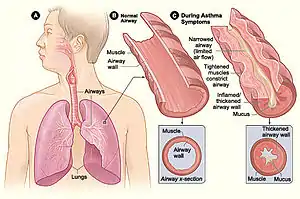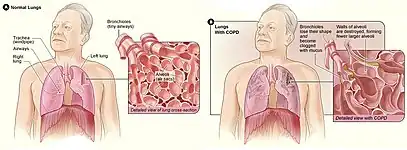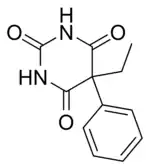Tedral
Tedral is a medicine formerly used to treat respiratory diseases such as asthma, chronic obstructive lung disease (COPD), chronic bronchitis, and emphysema.[1] It is a combination drug containing three active ingredients - theophylline, ephedrine, phenobarbital.[1] This medication relaxes the smooth muscle of the airways, making breathing easier.[2] The common side effects of Tedral include gastrointestinal disturbances, dizziness, headache and lightheadedness.[2][3][4] However, at high dose, it may lead to cardiac arrhythmias, hypertension, seizures or other serious cardiovascular and/or central nervous system adverse effects.[5][6][7] Tedral is contraindicated in individuals with hypersensitivity to theophylline, ephedrine and/or phenobarbital. It should be also used in caution in patients with cardiovascular complications, such as ischemic heart disease and heart failure and/or other disease conditions.[2][8] It can cause a lot of drug–drug interactions. Therefore, before prescribing patient with Tedral, drug interactions profile should be carefully checked if the patient had other concurrent medication(s). Being used as a treatment option for respiratory diseases for decades, Tedral was withdrawn from the US market in 2006 due to safety concerns.[9][10]
Medical uses

Tedral is an oral bronchodilator, which contains three active ingredients, including (1) theophylline, (2) ephedrine, and (3) phenobarbital.[12] It was indicated for the symptomatic relief of asthmatic bronchitis, chronic bronchial asthma, COPD or other bronchospastic disorders.[13] It was usually used as an added-on therapy in asthmatic patients with inadequate symptomatic control even with inhaled bronchodilators or inhaled corticosteroids.[14] Besides, it could also be used as a prophylactic treatment for the prevention of asthmatic attacks.[15]

Mechanism of action
There are three active ingredients in Tedral and they have different mechanisms of action.
1. Theophylline

Theophylline relaxes the bronchial smooth muscle and pulmonary artery smooth muscle. In addition, it also reduces the airway responsiveness to allergens, adenosine, methacholine, and histamine by two distinct mechanisms:[17]
- First, it acts as a competitive nonselective phosphodiesterase inhibitor to inhibit type III and type IV phosphodiesterase. The inhibition of type III and type IV phosphodiesterase leads to an increase in the concentration of intracellular cAMP, which then activates protein kinase A, and inhibits TNF-alpha, and leukotriene synthesis. Thereby, suppressing inflammation and innate immunity
- Second, theophylline is also a nonselective adenosine receptor antagonist, which acts on A1, A2, and A3 receptors with almost the same affinity. This possibly explains theophylline's cardiac effects. Adenosine-mediated channels also enhance diaphragmatic muscle contractility by promoting calcium uptake.
Other proposed mechanisms of action of theophylline include:[17]
- Inhibition of nuclear factor-kappaB to prevent the translocation of the pro-inflammatory transcription factor (NF-kappaB) to the nucleus. Thereby, reducing the expression of known inflammatory genes in COPD and asthma;
- Increases the secretion of interleukin-10, which has broad anti-inflammatory effects
- Decreases poly (ADP-ribose) polymerase-1 (PARP-1)
- Increases apoptosis of inflammatory cells, including T cells and neutrophils
- Increases histone deacetylase 2 by inhibiting phosphoinositide 3-kinase-delta.
2. Ephedrine

Ephedrine, a stereoisomer of pseudoephedrine, acts as a direct and indirect sympathomimetic amine. Its indirect mechanism makes it more unique than other sympathomimetic agents, for example, pseudoephedrine and phenylephrine.[18]
It directly binds to both alpha and beta receptors. However, its primary mechanism of action is indirectly achieved by the inhibition of neuronal norepinephrine reuptake and displacement of more norepinephrine from storage vesicles. These actions prolong the presence of norepinephrine in the synapse for binding to postsynaptic alpha and beta receptors. Thereby, leading to alpha- and beta-adrenergic stimulation.[18]
The stimulation of alpha-1-adrenergic receptors in vascular smooth muscle cells leads to an increase in systemic vascular resistance and, thus, systolic and diastolic blood pressure. Direct stimulation of beta-1 receptors by ephedrine and norepinephrine also increases cardiac chronotropy and inotropy. Lastly, stimulation of beta-2-adrenergic receptors in the lungs results in bronchodilation, however, the effect is less significant than those seen in the cardiovascular system.[18]

3. Phenobarbital
Phenobarbital prolongs the time that chloride channels are open. Thereby, depressing the central nervous system. This is accomplished by acting on GABA-A receptor subunits. When phenobarbital binds to these receptors, the chloride ion gates open and remain open, allowing these ions to enter neuronal cells steadily. This action causes the cell membrane to hyperpolarize, leading to a raise in the action potential threshold.[19]
Adverse effects
Theophylline
Due to the presence of theophylline in Tedral, the most common side effects of this drug include:[20][5]
- Gastrointestinal: nausea and vomiting, increased stomach acid secretion, and gastroesophageal reflux. These could be due to the inhibition of phosphodiesterase;
- Central nervous system: headache, lightheadedness, dizziness, insomnia, restlessness, and irritability.
However, at high serum concentrations, some serious adverse effects may occur:[20][5]
- Cardiovascular: convulsions, cardiac arrhythmias. These could be to adenosine A1-receptor antagonism
- Central nervous system: seizures, non-convulsive status epilepticus
Other adverse side effects include:[5]
- Neuromuscular and skeletal: tremor
- Genitourinary: difficulty in micturition in males with prostatism, transient diuresis
- Endocrine and metabolic: hypercalcemia in patients with concomitant hyperthyroid disease
Ephedrine
Ephedrine has both alpha- and beta-agonist effects. Owing to its sympathomimetic effect, the common side effects of Tedral include:[21][22]
- Gastrointestinal: nausea, vomiting
- Cardiovascular: tachycardia, hypertension, irregular pulse, palpitations, bradycardia
- Central nervous system: dizziness, anxiety, restlessness, and insomnia
Besides, ephedrine can cause cardiac arrhythmias. When ephedrine is used in long-term, the catecholamine excess can bring about contraction band necrosis of the myocardium, which predisposes the heart to ventricular arrhythmias.[23]
Phenobarbital
Phenobarbital also results in the adverse effects of Tedral. The most common side effects caused by phenobarbital are dizziness, sedation, incoordination, and impaired balance. However, these adverse effects affect geriatric patients to a greater extent.[24]
Concerning the adverse effects of phenobarbital after long-term usage, loss of appetite, depression, irritability, achiness in the bones, joints, or muscles, and liver damage may occur.[24]
Other reported adverse reactions include:[24]
- Cardiovascular: hypotension, bradycardia, syncope
- Central nervous system: confusion, agitation, somnolence, ataxia, hyperkinesia, hallucinations, anxiety, nightmares, thinking abnormality, psychiatric disturbance
- Respiratory: hypoventilation, apnea
- Gastrointestinal: nausea, vomiting, constipation
- Dermatologic reactions: exfoliative dermatitis, toxic epidermic necrolysis, Stevens-Johnson syndrome (rare)
Contraindications
Theophylline
Because one of the active ingredients in Tedral is theophylline, Tedral is contraindicated if the patient has:[25][5]
- Hypersensitivity to xanthine derivatives
- Coronary artery disease (cardiac stimulating effects of Theophylline may prove harmful)
- Peptic ulcer
- Concomitant use with ephedrine in children.
Ephedrine
Owing to the fact that Tedral also contains Ephrdrine, Tedral is contraindicated for patients who have:[8]
- Acute hypertension
- Tachycardia
Ephedrine raises both chronotropy and inotropy, increasing myocardial oxygen demand. Therefore, it has to be used in caution in patients with ischemic heart disease or heart failure. It should also be avoided in situations where tachycardia would be undesirable, for example aortic stenosis.[8]
Ephedrine's alpha-adrenergic stimulation causes contraction of the smooth muscle at the base of the bladder, resulting in resistance to urine output. It is, therefore, the use of Tedral in patients with urinary retention and prostatic hyperplasia has to be cautious.[8]
In addition, due to excessive norepinephrine availability at the synapse, which could induce a hypertensive crisis via the indirect sympathomimetic effect of ephedrine, Tedral should be avoided or used with caution within 14 days of monoamine oxidase inhibitor (MAOI) therapy.[23]
Phenobarbital
Tedral is also composed of phenobarbital, therefore, it is contraindicated for individuals with:[7][4][26]
- Hypersensitivity to phenobarbital, barbiturates or any component of the formulation.
- A history/manifest or latent porphyria
- Liver impairment
- Nephritic syndrome (at high dose)
- A history of sedative-hypnotic drug addiction
Drug interactions
Theophylline
Due to the presence of theophylline, Tedral interacts with:[27][5]
- Adenosine
- Allopurinol
- Alcohol
- Anti-psychotic agents
- Antithyroid agents
- Barbiturates
- Benzodiazepines
- Bupropion
- Beta-2 agonists
- Beta blockers
- CYP1A2 inhibitors
- CYP1A2 inducers
- Cambendazole
- Clarithromycin
- Erythromycin
- Interleukin-6 (IL-6) inhibiting therapies
- Iohexol
- Levothyroxine
- Methotrexate
- Quinine
- Verapamil
- Zafirlukast
Theophylline disease interactions
Theophylline cause interactions of Tedral with the following diseases:
- Peptic ulcer disease (PUD)
- Renal dysfunction
- Seizure disorders
Ephedrine
Because of the presence of ephedrine, Tedral interacts with:[28][29]
- Alkalinizing agents
- Alpha-1 blockers
- Beta blockers
- Cannabinoid-containing products
- Carbonic anhydrase inhibitors
- Clonidine
- Clozapine
- Inhalation Anesthetics
- Iobenguane radiopharmaceutical products
- Monoamine oxidase inhibitors
- Quinidine
- Serotonin / norepinephrine reuptake inhibitors
- Sympathomimetics
- Tricyclic antidepressants
- Urinary acidifying agents
Ephedrine disease interactions
Since ephedrine is one of the active ingredients in Tedral, Tedral interacts with the following disease:
Phenobarbital
Since Tedral contains phenobarbital, it interacts with:[7][30]
- Acetaminophen
- Blood pressure lowering agents
- Cannabinoid-containing products
- CNS depressants
- Doxycycline
- Local anesthetics
- Magnesium Sulfate
- Procarbazine
- Quinine
Phenobarbital disease interactions
With phenobarbital being one of the active ingredients in Tedral, Tedral interacts with the following disease:
- Acute alcohol intoxication
- Drug dependence
- Liver disease
- Porphyria
- Rash
- Respiratory depression
- Cardiovascular
- Prolonged hypotension
- Renal dysfunction
History
The history of Tedral can be traced back to the early 20th century when theophylline was first isolated from tea leaves and later found to have bronchodilator properties.[31] In the 1920s and 1930s, ephedrine was introduced as a treatment for asthma and other respiratory conditions due to its bronchodilating effect and ability to increase blood flow to the lungs.[32]
The combination of theophylline and ephedrine was first used in the 1940s as a treatment for asthma, and the addition of a barbiturate such as pentobarbital or phenobarbital was later added to enhance the sedative effects of the medication and improve patient compliance.[33]
Tedral was first marketed by the pharmaceutical company Eli Lilly and Company in the 1950s as a treatment for asthma and other respiratory conditions, and later sold to Novartis Pharmaceuticals Corporation.[34] It was widely used throughout the 1960s and 1970s, but its popularity declined in the 1980s due to the development of newer, more effective medications for asthma and COPD, such as inhaled corticosteroids, long-acting beta-agonists, leukotriene modifiers and immunomodulators.[35]
Tedral was withdrawn from the US market in 2006 due to safety concerns related to the use of ephedrine. The US Food and Drug Administration (FDA) had previously issued warnings about the use of ephedrine-containing products due to their potential for serious side effects, including heart attack, stroke, and death.[36] In response, many pharmaceutical companies voluntarily removed their ephedrine-containing products from the market. In the case of Tedral, its manufacturer, Novartis Pharmaceuticals Corporation, voluntarily withdrew the medication from the market in 2006 after the FDA issued a warning letter to the company citing safety concerns related to the use of ephedrine.[37]
Reference
- "Tedral (Oral)". Drugs.com. Retrieved 2023-04-09.
- Jilani, Talha N.; Preuss, Charles V.; Sharma, Sandeep (2023), "Theophylline", StatPearls, Treasure Island (FL): StatPearls Publishing, PMID 30085566, retrieved 2023-04-09
- "Ephedrine". Martindale: The Complete Drug Reference. Retrieved 2023-04-09.
- Lewis, Cassaundra B.; Adams, Ninos (2023), "Phenobarbital", StatPearls, Treasure Island (FL): StatPearls Publishing, PMID 30335310, retrieved 2023-04-09
- "Theophylline: Drug information". UpToDate. Retrieved 2023-04-09.
- "Ephedrine (systemic): Drug information". UpToDate. Retrieved 2023-04-09.
- "Phenobarbital: Drug information". UpToDate. Retrieved 2023-04-09.
- Statler, Alec K.; Maani, Christopher V.; Kohli, Arpan (2023), "Ephedrine", StatPearls, Treasure Island (FL): StatPearls Publishing, PMID 31613441, retrieved 2023-04-09
- "FDA Announces Final Rule on Ephedrine Alkaloids". U.S. Food and Drug Administration. 2004.
- "Novartis Voluntarily Withdraws Tredral from the Market". U.S. Food and Drug Administration. 2006.
- "Asthma - Symptoms | NHLBI, NIH". www.nhlbi.nih.gov. 24 March 2022. Retrieved 2023-04-09.
- "Tedral Advanced Patient Information". Drugs.com. Retrieved 2023-03-27.
- "Ephedrine and theophylline: International drug information (concise)". UpToDate. Retrieved 2023-03-27.
- Barnes, Peter J. (2013). "Theophylline". American Journal of Respiratory and Critical Care Medicine. 188 (8): 901–906. doi:10.1164/rccm.201302-0388PP. PMID 23672674.
- "Ephedrine and theophylline: International drug information (concise)". UpToDate. Retrieved 2023-03-27.
- "COPD - What Is COPD? | NHLBI, NIH". www.nhlbi.nih.gov. 24 March 2022. Retrieved 2023-04-09.
- Jilani, Talha N.; Preuss, Charles V.; Sharma, Sandeep (2023), "Theophylline", StatPearls, Treasure Island (FL): StatPearls Publishing, PMID 30085566, retrieved 2023-03-29
- Statler, Alec K.; Maani, Christopher V.; Kohli, Arpan (2023), "Ephedrine", StatPearls, Treasure Island (FL): StatPearls Publishing, PMID 31613441, retrieved 2023-03-29
- Lewis, Cassaundra B.; Adams, Ninos (2023), "Phenobarbital", StatPearls, Treasure Island (FL): StatPearls Publishing, PMID 30335310, retrieved 2023-03-28
- Jilani, Talha N.; Preuss, Charles V.; Sharma, Sandeep (2023), "Theophylline", StatPearls, Treasure Island (FL): StatPearls Publishing, PMID 30085566, retrieved 2023-03-30
- "Ephedrine (systemic): Drug information". UpToDate. Retrieved 2023-03-31.
- "Ephedrine". Martindale: The Complete Drug Reference. Retrieved 2023-03-31.
- Statler, Alec K.; Maani, Christopher V.; Kohli, Arpan (2023), "Ephedrine", StatPearls, Treasure Island (FL): StatPearls Publishing, PMID 31613441, retrieved 2023-03-31
- Lewis, Cassaundra B.; Adams, Ninos (2023), "Phenobarbital", StatPearls, Treasure Island (FL): StatPearls Publishing, PMID 30335310, retrieved 2023-03-31
- Jilani, Talha N.; Preuss, Charles V.; Sharma, Sandeep (2023), "Theophylline", StatPearls, Treasure Island (FL): StatPearls Publishing, PMID 30085566, retrieved 2023-03-31
- "Phenobarbital: Drug information". UpToDate. Retrieved 2023-04-09.
- "Theophylline Drug Interactions". Drugs.com. Retrieved 2023-04-09.
- "Ephedrine Drug Interactions". Drugs.com. Retrieved 2023-04-09.
- "UpToDate". www.uptodate.com.
- "Phenobarbital Drug Interactions". Drugs.com. Retrieved 2023-04-09.
- "Theophylline" (PDF). American Thoracic Society.
- "Ephedrine". MedlinePlus. 2022.
- "Pentobarbital". MedlinePlus. 2022.
- "Tedral product information" (PDF). Eli Lilly and Company. 2008.
- "Global Strategy for Asthma Management and Prevention". Global Initiative for Asthma.
- "FDA Announces Final Rule on Ephedrine Alkaloids". U.S. Food and Drug Administration. 2004. Retrieved 2023-04-09.
- "Novartis Voluntarily Withdraws Tredral from the Market". U.S. Food and Drug Administration. 2006. Retrieved 2023-04-09.